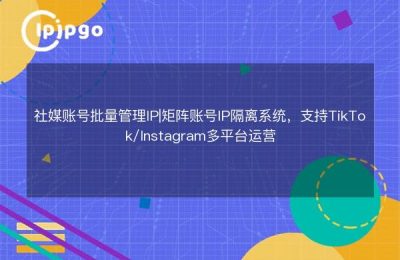
As an Android app developer, we often face the problem of proxy IPs when doing group control testing. Proxy IP can help us hide the real IP address and prevent it from being blocked, but in Android group control, there are often some annoying little problems. Below, I'll share the proxy IP problems encountered in Android group control and the solutions.
Proxy IP selection and acquisition
First of all, we need to get a proxy IP from a reliable channel, such as some paid IP proxy service providers or self-built proxy IP pool. When choosing a proxy IP, we need to consider the stability, speed and regional coverage of the IP to ensure that it can meet our testing needs.
Code example to get proxy IP:
Proxy proxy = new Proxy(Proxy.Type.HTTP, new InetSocketAddress(ip, port));
URLConnection connection = new URL(url).openConnection(proxy);Proxy IP switching and management
In Android group control, we may need to switch proxy IPs frequently to deal with some anti-crawler measures or to improve the success rate of requests. Therefore, proxy IP switching and management is especially important. We can maintain a pool of proxy IPs and check the availability of each IP regularly, so that when an IP fails, it can be replaced in time.
Proxy IP switching example:
System.setProperty("http.proxyHost", "your_proxy_host"); System.setProperty("http.proxyHost", "your_proxy_host");
System.setProperty("http.proxyPort", "your_proxy_port");;Avoiding Proxy IP Recognition
Some websites or applications will identify the proxy IP by some means, which will cause our test task to fail if it is recognized. To avoid this, we can try to use a highly anonymous proxy IP or customize some HTTP request headers to simulate the behavior of real users.
Example of using a highly anonymized proxy IP:
Proxy proxy = new Proxy(Proxy.Type.HTTP, new InetSocketAddress(ip, port));
HttpURLConnection connection = (HttpURLConnection) url.openConnection(proxy);
connection.setRequestProperty("User-Agent", "Mozilla/5.0 (Windows NT 10.0; Win64; x64) AppleWebKit/537.36 (KHTML, like Gecko) Chrome/58.0. 3029.110 Safari/537.3").
Detecting Proxy IP Availability
In order to ensure the stability and availability of proxy IPs, we need to regularly check whether the proxy IPs can access the target websites or applications normally. If you find that an IP fails frequently, you need to reject and add new IPs in time to maintain the stability of the whole proxy IP pool.
Example of detecting proxy IP availability:
try {
URL url = new URL("http://www.target.com");
Proxy proxy = new Proxy(Proxy.Type.HTTP, new InetSocketAddress(ip, port));
HttpURLConnection connection = (HttpURLConnection)url.openConnection(proxy); int responseCode = connection.getConnection(proxy); int responseCode = connection.getConnection(proxy)
int responseCode = connection.getResponseCode(); int responseCode = connection.getResponseCode()
if (responseCode == 200) {
// Proxy IP available
} else {
// Proxy IP is invalid, remove it from the proxy pool.
}
} catch (IOException e) {
// Proxy IP is invalid, remove from proxy pool.
}summarize
Proxy IP is a very important auxiliary tool when performing Android group control testing. We need to pay attention to the selection and acquisition, switching and management of proxy IPs to avoid being recognized and detect the availability of proxy IPs to ensure that the testing task can be carried out smoothly. I hope the above sharing will be helpful to you, and welcome you to leave a message to exchange discussions.








